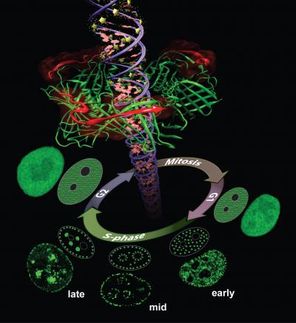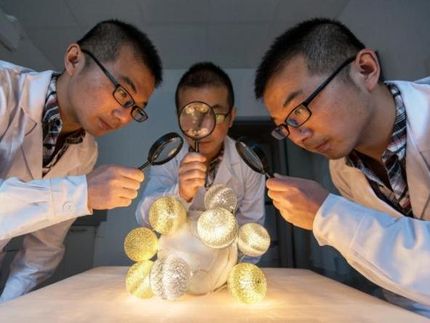Naturally fluorescent molecules may serve as cancer biomarker
Excess amounts of a naturally fluorescent molecule found in all living cells could serve as a natural biomarker for cancer, according to bioengineers. NADH, or nicotinamide adenine dinucleotide, is a key coenzyme found mostly in the inner membrane of a cell's power plant, or mitochondria. It fuels a series of biochemical reactions that involve various enzymes to produce ATP, the major energy source in cells. In the event of disease or a metabolic disorder, these enzymes and their related reactions can become disabled, causing a buildup of unused NADH.
"Dysfunctional enzymes in the mitochondria are known to be associated with serious health problems such as cancer and neurodegenerative diseases," said Ahmed Heikal, associate professor of bioengineering, Penn State. "By detecting the level of NADH and its distribution inside living cells, we should be able to monitor the mitochondrial activity and thus the integrity of any given cell, without adding potentially toxic dyes or actually destroying the cell."
According to Heikal, one of the main challenges in cancer diagnosis is the ability to differentiate cancer cells from normal ones at the early stages of tumor progression. To tease apart the critical difference between normal and cancerous cells, the researchers used the fluorescence of natural NADH. Using a combination of state-of-the-art spectroscopy and microscopy techniques, the researchers were able to convert such fluorescence into an accurate measure of NADH concentration in live cells. Heikal and Yu, graduate student, bioengineering, have found that the average concentration of NADH in breast cancer cells is about twice that in normal breast cells.
"If we are given two live cells, one normal and the other cancerous, we could differentiate between the two with confidence," said Heikal, whose team's findings appear today (April 2) in the Journal of Photochemistry and Photobiology B: Biology. "For the first time, we have been able to quantify the concentration of NADH in both live breast cells and breast cancer cells."
The researchers also looked at the amounts of NADH in the cell that is free and how much is bound to other enzymes. These amounts are different in normal and cancer cells.
"We realized that the fluorescence intensity not only depends upon the concentration of NADH but also on its structure - free or enzyme-bound - as well as its place inside the cell - in the cytoplasm (non-nucleus part of the cell) or in mitochondria," explained Heikal. "Since a free NADH molecule would rotate - tumble - faster than enzyme-bound NADH, we were able to develop a technique called rotational diffusion imaging to establish a direct measure of the concentrations of free and enzyme-bound NADH throughout a living cell, whether in the cytosol (cell fluid) or the mitochondria."
To confirm their findings that disruption of chemical reactions that produce ATP can lead to an increase in NADH, Heikal and Yu exposed normal breast cells to potassium cyanide, a known inhibitor of some of these critical mitochondrial enzymes. The researchers found that the NADH concentration in the normal cells increased when exposed to potassium cyanide. The relative amounts of NADH in the mitochondria also rose significantly.
Other researchers have previously measured the amount of NADH in cells using conventional biochemical techniques that require destroying the cells. However, Heikal believes measurements of dead cells provide no information about NADH distribution in the cells and may not be accurate or relevant for diagnostic or clinical use.
"The advantage of our non-destructive approach is that the NADH location in a cell relates to its function in cell survival," explained Heikal. "When you destroy the cell, you do not know where the NADH molecules existed inside the cell and what role they might have played in cell survival. For accurate diagnosis, you need to have the cellular context to better understand the problem."
According to the Penn State researcher, the ability to accurately measure NADH levels in a cell without killing it could have potential implications for related research on human health and drug delivery.
"Our technique is not limited to detecting cancer. Other neurodegenerative diseases related to mitochondrial anomalies can also be detected with our method," Heikal said. "We can also use our approach to quantify the efficiency of a new drug on manipulating the activities of mitochondrial enzymes associated with energy production in cells."
Other news from the department science
Most read news
More news from our other portals
See the theme worlds for related content
Topic World Spectroscopy
Investigation with spectroscopy gives us unique insights into the composition and structure of materials. From UV-Vis spectroscopy to infrared and Raman spectroscopy to fluorescence and atomic absorption spectroscopy, spectroscopy offers us a wide range of analytical techniques to precisely characterize substances. Immerse yourself in the fascinating world of spectroscopy!

Topic World Spectroscopy
Investigation with spectroscopy gives us unique insights into the composition and structure of materials. From UV-Vis spectroscopy to infrared and Raman spectroscopy to fluorescence and atomic absorption spectroscopy, spectroscopy offers us a wide range of analytical techniques to precisely characterize substances. Immerse yourself in the fascinating world of spectroscopy!




























































